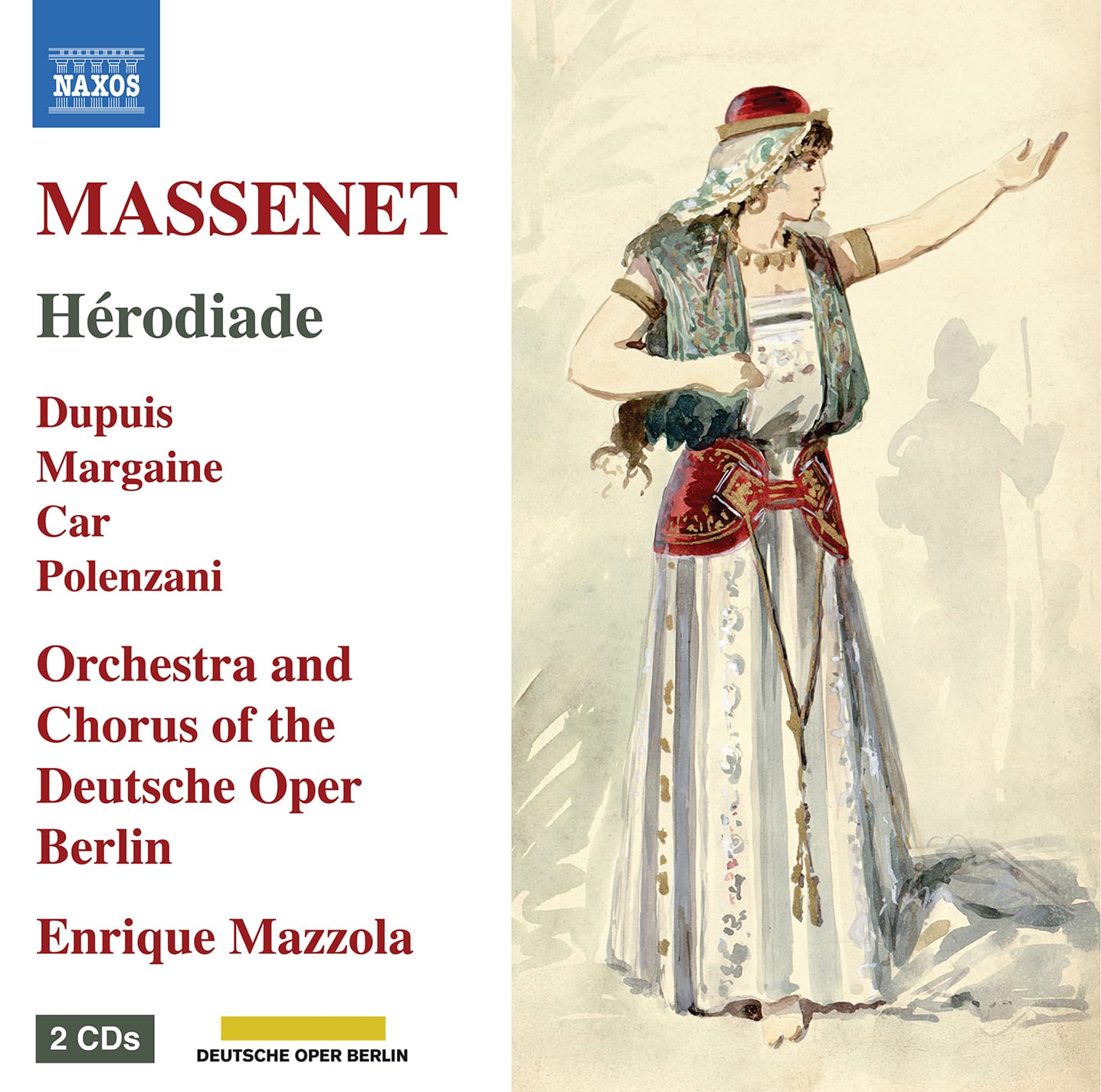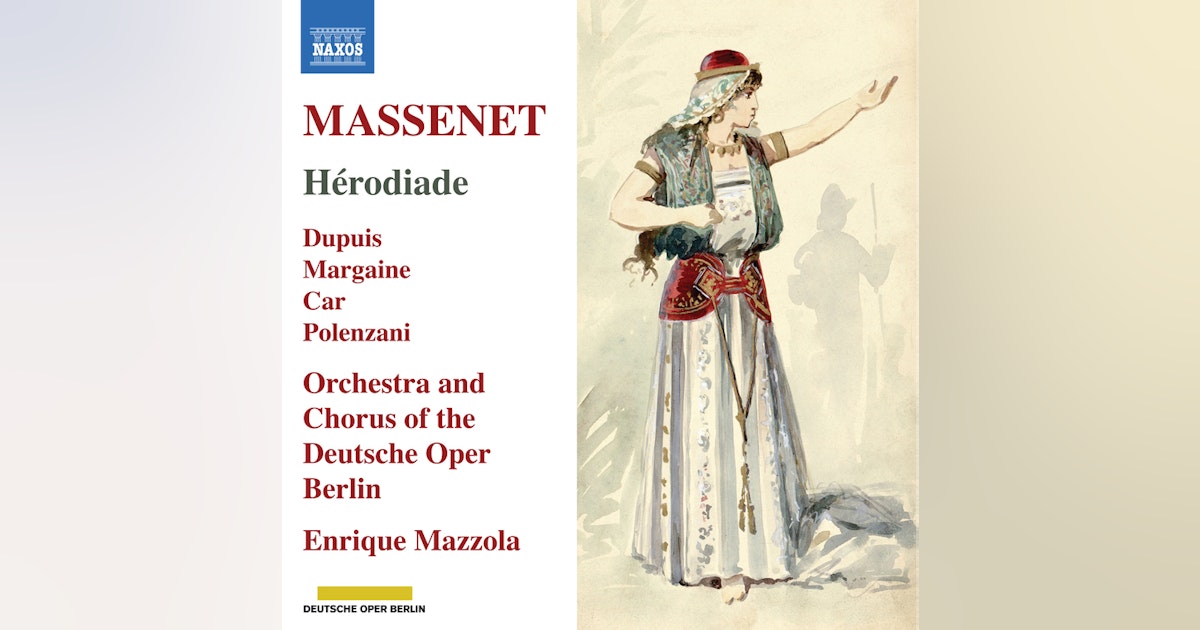
A real reminder of Massenet’s operatic genius here. This is the story of Salomé, later injected into operatic history books by Richard Strauss, but here set by Jules Massenet in a four-act opera with a libretto by Paul Milliet and Georges Hartmann based on a draft scenario by Angelo Zamardini. It is performed here in its four act, 1884 revision (the original dates from 1878/9).
There are some international hard-hitters here: conductor Enrique Mazzola is music director of the Lyric Opera of Chicago, while Étienne Dupuis (Hérode) and Mathew Polenzani (Jean, or John the Baptist) will need little introduction.
Mazzola conducts very well: lyrical sections stretch out nicely, and yet there is dynamism too: try the juxtaposition between the opening Introduction and the Chorus that follows (“Alerte!”):
When it comes to Massenet opéra, it tends to be a few big hitters that dominate. Looking back over my reviews over the decades, there’s a Werther from Modena (review), Cendrillon from Covent Garden with DiDonato (review) and from Glyndebourne with DeNiese and Kate Lindsey (review) , and Werthers also from Coven Garden with Kaufmann and Akhmetshina (review) and Villazón and Sophie Koch (review), plus a Manon from New York with Netrebko (review), although one must not forget a rare outing for Le roi de Lahore courtesy of Chelsea Opera Group in 2015 (review)
Let’s start looking at he music. Salome’s first aria (‘Il est doux, il est bon’) has a gentle sway to it and Nicole Car sounds fabulous:
As Hérode, Etienne Dupuis is outstanding (try his aria in act 1, scene 2). Dupuiis sounds amazing in his “Vision fugitive,” a voice of honey; and how unexpected is the sound of a saxophone in this aria! And yet it fits so perfectly; and how beautifully shaded, and dynamically varied, is the aria itself, which rises to a massive climax.
As a bonus, here’s Dupois live in just this aria in Paris 2022. Daniele Rustioni conducts the orchestra of the Opéra de Lyon; it is recorded in the lovely Théâtre des Champs-Elysées:
The mezzo Clémenin Margaine is fabulously rich and emotive (we need something of a Verdian mezzo in this role), particularly in he third act duet with Marko Mimico’s dark-hued Phanuel (who is authoritative and commanding throughout). Here’s the whole of the firs Tableau of the third act:
As Jean, Matthew Polenzani is heroic voice, while his scene at the end of act 1 with Salomé is beautiful; there is a real sense of grandeur and space towards the end of the act:
The second act consists of two tableaux and begins in Herod’s palace. Dupuis sounds fantastic as Hérod; and how pure Massenet is the all-too-brief “Danse babylonienne”.
The Young Babylonienne, Sue Jo, a graduate of Houston Grand Opera Studio, who grasps her moment with aplomb in the Oriental-sounding “Maître, bois dans cette amphora” (here it has the introductory passage with it):
There are some phenomenal moments here: including a friendship duet that seems to nod to Verdi’s Don Carlos …
Of the four acts, only act one is not split into two tableaux. But it does contain contasts: between the fervent duet between Phanuel and Héordiade and a far darker orchestral Prélude (marked “andante sostenuto religioso”).
Nicole Car is transfixing in the final act, her big moment as it were. This is a live performance, and its at moments like this that one really hears the electricity. She shapes her aria to a fine climax (“Charme des jours passées”):
Dupuis’ response is just as fine (listen to his relishing of singing Salomé’s name in his answering, and balancing, aria). Massenet asks for a starker and darker sound in this act: listen to the “Marche saint” (Holy March):
This fourth and final act balances the first in brevity (although it, unlike act 1, is in two tableeaux). Jean’s “Adieu don”c is magnificent, especially the final cries of “Seigneur”.The first scene finds Salome and Jean alone, and this is some of Mssenet’s tenderest music. My only criticism I that thee is a bit of a sag in the final duet of the first tableau …
In massive contrast comes the bright, bash and energetic chorus that opens the final act’s second tableau, the German chorus in fine fettle. Mazzola’s sheer energy is an indicator of his authority in this music. Mazzola is superb pretty much throughout, but nowhere more so than in his pacing of the third act, the ensemble towards the end (“J’ai vecu de sa vie et mourn de sa mort … C’est Dieu Queen l’on le nommé”) carrying huge weight, the interruptive gesture of “Prêtres, vows daisies vrai!” visceral.
Looking elsewhere, a intriguingly, there is a coupling of Massenet’s Hérodiade with Richard Strauss’ Salome on the Gala label: the Massenet stars Grace Bumbry, recorded in Nice, France in 1987. Of course there are other recordings that are vital here, not least Plasson from Toulousewith Studer, Heppner, Thomas Hampson, Nadine Deniza and José van Dam. There is one by Gergiev, currently persona non grata in teh musical world but featuring Renée Fleming and Domingo. I believe for some time a French Radio recording conducted by David Lloyd-Jones was the only available one (Muriel de Channes as Salomé and Nadine Denize in teh title role, regionally on Rodolphe and later on Opera d’Oro. There is even, if you can find it, an EMI LP of highlights with the great régime Crespin. But this new Naxos remains a major release..
The Naxos release offers two very well-filled discs: 77|49 and 81″32. It captures a valuable event as there haven’t been that many performances of this opera in recent years: Palazetto BruZane did it in Lyon and Paris conducted by Daniele Rustioni in 2022 (see the above video) with some cross-over of cast with Berlin (Car and Dupuis); Opéra de Marseille presented it in 2018, while in the States it has outed only once recently, in New York, but not the Met: New Amsterdam Opera in 2019.
The overall performance history of Hérodiadeitself is far from straightforward either. Héordiade was the first French opéra to be premiered in Brussels (at la Monnaie in 1881) thanks to the disinterest of the Paris Opéra (Reyer’s Sigurd followed a similar path in 1884)
Finally, this set (twofer) also cares one of Naxos’ finest ever booklets. No text/translation, alas, but a fabulously informed essay by Anselm Gerhard.
I end with an historical treat: one of the greatest tenors you’ve (probably) never heard of, Leon Campagnola (born Marseille, 1875!). who became known as the French Caruso, perhaps due to the dark hue of the low register (he started off as a baritone) Here he is in “Ne pouvant remprimer” from Hérodiade (follow the link to Spotify: thereto is an all-Campgnola disc issued by Malibran Music) and for further enjoyment, here’s a remarkable, radiant duet from Gounod’s beautiful opéra Roméo et Juliette, with Berthe César (1879-1973), recorded for HMV in 1912:
This Naxos set is available via Amazon here.









